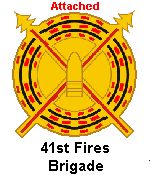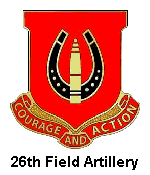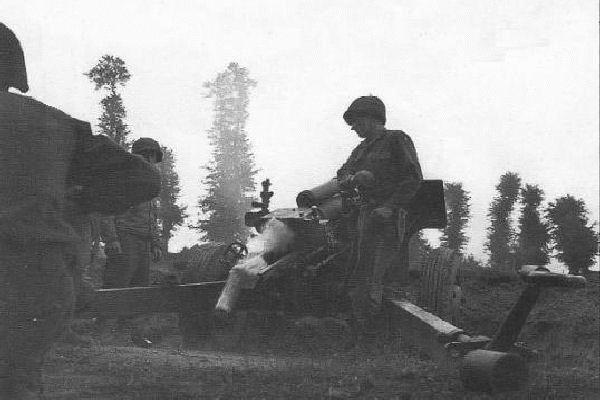

"A" Btry, 26st Field Artillery
Historical Missions
"Courage And Action"



 United States Artillery can be traced back to the Military Company of
Massachusetts, which was chartered in 1638, and with other colonial artillery
companies formed what became the Continental Artillery. More than a century
later, in April 1775, the legislature authorized the formation of an artillery
regiment. This unit was first commanded by Colonel Richard Gridley, a former
British artillery officer who later was replaced by Colonel Henry Knox.
Colonel Knox eventually became the Chief of Artillery and is credited with
shaping artillery tactics for the remainder of the Revolution.
United States Artillery can be traced back to the Military Company of
Massachusetts, which was chartered in 1638, and with other colonial artillery
companies formed what became the Continental Artillery. More than a century
later, in April 1775, the legislature authorized the formation of an artillery
regiment. This unit was first commanded by Colonel Richard Gridley, a former
British artillery officer who later was replaced by Colonel Henry Knox.
Colonel Knox eventually became the Chief of Artillery and is credited with
shaping artillery tactics for the remainder of the Revolution.
 From the historical battlefields of Yorktown and Gettysburg, through the
Western Plains, Mexican and Spanish American Wars, the artillery was always
there. In fact, the nickname, "Redlegs", comes from that era when artillery
uniforms had a 2-inch red stripe on their trousers and horse artillery men
wore red canvas leggings. Continuing through the modern days of the European
and Asian Theaters of WWII, the Pusan Perimeter in Korea, the Ia Drang Valley
in Vietnam, to the "Steel Rain" of Desert Storm, "Redlegs" have served with
distinction and valor in all of our country's armed conflicts.
From the historical battlefields of Yorktown and Gettysburg, through the
Western Plains, Mexican and Spanish American Wars, the artillery was always
there. In fact, the nickname, "Redlegs", comes from that era when artillery
uniforms had a 2-inch red stripe on their trousers and horse artillery men
wore red canvas leggings. Continuing through the modern days of the European
and Asian Theaters of WWII, the Pusan Perimeter in Korea, the Ia Drang Valley
in Vietnam, to the "Steel Rain" of Desert Storm, "Redlegs" have served with
distinction and valor in all of our country's armed conflicts.
 The Early Years, 1916
The Early Years, 1916

 The 26th Field Artillery was organized in August 1918 at Camp McClellan,
Alabama. The regiment served within the continental limits of the United
States during World War I and was demobilized on February 9th, 1919 at Camp
McClellan, Alabama. In 1923, the 26th Field Artillery was reconstituted as an
inactive unit of the Regular Army and allotted to the Fourth Corps Area.
The 26th Field Artillery was organized in August 1918 at Camp McClellan,
Alabama. The regiment served within the continental limits of the United
States during World War I and was demobilized on February 9th, 1919 at Camp
McClellan, Alabama. In 1923, the 26th Field Artillery was reconstituted as an
inactive unit of the Regular Army and allotted to the Fourth Corps Area.
 World War II European Theater 1941 - 1945
World War II European Theater 1941 - 1945

 |
|---|
| 26th FA In Normandy, France - 1944 |
|---|
| |
|---|
 On 01 August 1940, the Regiment was reactivated at Fort Bragg, Norh Carolina. Regiment reorganized
and redesignated 26th Field Artillery Battalion and remained an element of 9th
Infantry Divisio, First Army. On 01 October 1940, the three battalions of the
26th Field Artillery were re-designated as three separate battalions under the
Commanding General, Ninth Division Artillery, and the old first battalion then
became the 26th Field Artillery Battalion.
On 01 August 1940, the Regiment was reactivated at Fort Bragg, Norh Carolina. Regiment reorganized
and redesignated 26th Field Artillery Battalion and remained an element of 9th
Infantry Divisio, First Army. On 01 October 1940, the three battalions of the
26th Field Artillery were re-designated as three separate battalions under the
Commanding General, Ninth Division Artillery, and the old first battalion then
became the 26th Field Artillery Battalion.
 Equipped with towed 105-millimeter howitzers, the Battalion participated in
the Carolina Maneuvers (supported the 39th Infantry) during October and
November 1941. Following the maneuvers, the Battalion underwent amphibious
training under Amphibious Corps, Atlantic Fleet (later redesignated Fleet
Marine Force, Atlantic).
Equipped with towed 105-millimeter howitzers, the Battalion participated in
the Carolina Maneuvers (supported the 39th Infantry) during October and
November 1941. Following the maneuvers, the Battalion underwent amphibious
training under Amphibious Corps, Atlantic Fleet (later redesignated Fleet
Marine Force, Atlantic).
In September, the unit deployed to the Europen/Africian Theater of Operations and
and on 08 November 1942, participated in the Invasion of North Africa (as an
element of Regimental Combat Team 39). Moving into and through the
Mediterrenean Sea, landed in Sicily 15 July 1943 (D-Day + 5). Following their
return to England on 27 November 1943, the next major mission undertaken was
re-equipping , training and staging for their 09 June 1944 (D-Day + 3) landing
in France.
 Korean War 1950 - 1951
Korean War 1950 - 1951

 Vietnam War 1965 - 1972
Vietnam War 1965 - 1972


 Iraqi Freedom - I 2003
Iraqi Freedom - I 2003


 Iraqi Freedom - IV 2006 - 2008
Iraqi Freedom - IV 2006 - 2008


 Iraqi Freedom - VI 2008 - 2010
Iraqi Freedom - VI 2008 - 2010


 Iraqi Draw Down 2009 - 2010
Iraqi Draw Down 2009 - 2010


 Operation "New Dawn" 2010 - 2011
Operation "New Dawn" 2010 - 2011



Needs Data















 eMail Your WebSite Comments.
eMail Your WebSite Comments.


 Return to "MyOwnPages"©.
Return to "MyOwnPages"©.

Copyright © 1996, Cavalry Outpost Publications ® and
Trooper Wm. H. Boudreau, "F" Troop, 8th Cavalry Regiment (1946 - 1947). All
rights to this body of work are reserved and are not in the public domain, or
as noted in the bibliography. Reproduction, or transfer by electronic means,
of the History of the 1st Cavalry Division, the subordinate units or any
internal element, is not permitted without prior authorization. Readers are
encouraged to link to any of the pages of this Web site, provided that proper
acknowledgment attributing to the source of the data is made. The information
or content of the material contained herein is subject to change without
notice.
Revised 29 Nov '12 SpellChecked



![]()



![]()
![]() From the historical battlefields of Yorktown and Gettysburg, through the
Western Plains, Mexican and Spanish American Wars, the artillery was always
there. In fact, the nickname, "Redlegs", comes from that era when artillery
uniforms had a 2-inch red stripe on their trousers and horse artillery men
wore red canvas leggings. Continuing through the modern days of the European
and Asian Theaters of WWII, the Pusan Perimeter in Korea, the Ia Drang Valley
in Vietnam, to the "Steel Rain" of Desert Storm, "Redlegs" have served with
distinction and valor in all of our country's armed conflicts.
From the historical battlefields of Yorktown and Gettysburg, through the
Western Plains, Mexican and Spanish American Wars, the artillery was always
there. In fact, the nickname, "Redlegs", comes from that era when artillery
uniforms had a 2-inch red stripe on their trousers and horse artillery men
wore red canvas leggings. Continuing through the modern days of the European
and Asian Theaters of WWII, the Pusan Perimeter in Korea, the Ia Drang Valley
in Vietnam, to the "Steel Rain" of Desert Storm, "Redlegs" have served with
distinction and valor in all of our country's armed conflicts.![]() The 26th Field Artillery was organized in August 1918 at Camp McClellan,
Alabama. The regiment served within the continental limits of the United
States during World War I and was demobilized on February 9th, 1919 at Camp
McClellan, Alabama. In 1923, the 26th Field Artillery was reconstituted as an
inactive unit of the Regular Army and allotted to the Fourth Corps Area.
The 26th Field Artillery was organized in August 1918 at Camp McClellan,
Alabama. The regiment served within the continental limits of the United
States during World War I and was demobilized on February 9th, 1919 at Camp
McClellan, Alabama. In 1923, the 26th Field Artillery was reconstituted as an
inactive unit of the Regular Army and allotted to the Fourth Corps Area.![]() Equipped with towed 105-millimeter howitzers, the Battalion participated in
the Carolina Maneuvers (supported the 39th Infantry) during October and
November 1941. Following the maneuvers, the Battalion underwent amphibious
training under Amphibious Corps, Atlantic Fleet (later redesignated Fleet
Marine Force, Atlantic).
Equipped with towed 105-millimeter howitzers, the Battalion participated in
the Carolina Maneuvers (supported the 39th Infantry) during October and
November 1941. Following the maneuvers, the Battalion underwent amphibious
training under Amphibious Corps, Atlantic Fleet (later redesignated Fleet
Marine Force, Atlantic).![]()
![]()
![]()
![]()
![]()
![]()
![]()







![]() eMail Your WebSite Comments.
eMail Your WebSite Comments.
![]()
![]()
![]() Return to "MyOwnPages"©.
Return to "MyOwnPages"©.
![]()